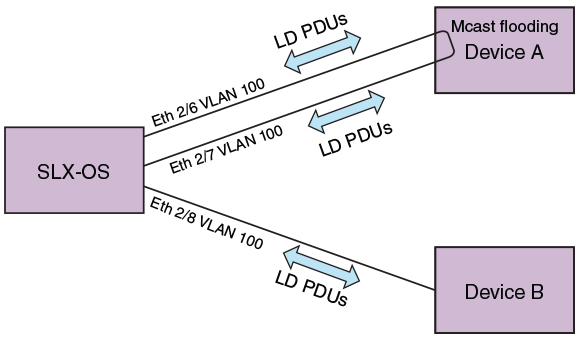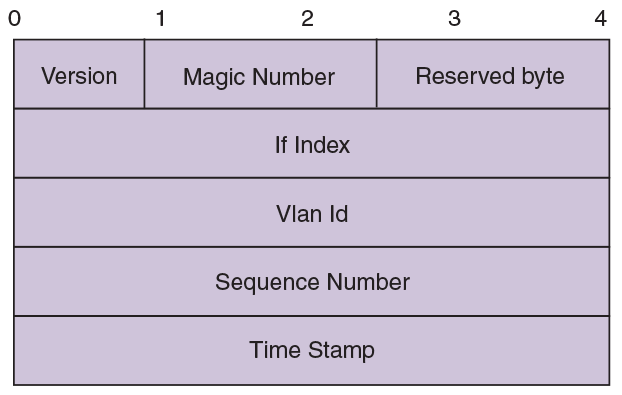LD protocol overview
The loop detection (LD) protocol is an Extremeproprietary protocol used to detect and break Layer 2 loops caused by misconfigurations, thereby preventing packet storms.
Layer 2 networks rely on learning and flooding to build their forwarding databases. Because of the flooding nature of these networks, any loops can be disastrous as they cause broadcast storms.

Important
The LD feature should be used only as a tool to detect loops in the network. It should not be used to replace other Layer 2 protocols such as STP.- Strict and loose modes
- Multi-Chassis Trunk (MCT)
- Breakout ports
- EPVN VLAN tunnels
LD protocol data units (PDUs) are initiated and received on the native device. Loop detection and action on the port state is also done on the same native device. Intermediate devices in the network must be capable of flooding unknown Layer 2 unicast PDUs on the VLAN through which they are received.
Strict mode
In what is referred to as strict mode, LD is configured on an interface. If the LD PDU is sent on an interface and received on the same interface, that port is shut down by LD. Strict mode overcomes specific hardware issues that cause packets to be echoed back to the input port. The following figure illustrates strict mode.

If the user provides a VLAN, then the PDUs are tagged accordingly. Otherwise PDUs are sent untagged. With a LAG, PDUs are sent out on the port-channel interface. If Device A has a loop (for example, a LAG is not configured), then the PDU is flooded back to SLX-OS, which detects the loop. In case of a loop, the port-channel interface is shut down. The following figure illustrates LD on a LAG.

LD supports 256 instances of strict mode.
Loose mode
In what is referred to as loose mode, LD is configured on a VLAN. If a VLAN in the device receives an LD PDU that originated from the same device on that VLAN, this is considered to be a loop and the receiving port is shut down. In loose mode, LD works at the VLAN level and takes action at the logical interface (LIF) level. The following figure illustrates loose mode, with LD on a VLAN.

SLX-OS generates the LD PDUs on the VLAN. if Device A has a loop, PDUs are flooded back to SLX-OS, which detects the loop. SLX-OS then shuts down the receiving LIF of the port on the VLAN.
LD supports 256 instances of loose mode, which means that it can be enabled on 256 VLANs.
LD PDU format
The following figure illustrates the format of the LD PDU in bytes.

| Parameter | Definition |
|---|---|
| Version | LD protocol version (1 by default) |
| Magic Number | 0x13EF; used to differentiate between LD multicast PDUs and other multicast PDUs |
| Reserved byte | For future use |
| If Index | Index of the source port; populated only in strict mode |
| Vlan Id | VLAN ID |
| Sequence Number | Reserved for future enhancements |
| Time Stamp | Reserved for future enhancements |
LD PDU transmission
Each LD-enabled interface or VLAN on a device continually transmits Layer 2 LD PDUs at a 1-second default hello-timer interval, with the destination MAC address as the multicast address. The multicast MAC address is derived from the system MAC address of the device with the multicast bit (8) and the local bit (7) set.
For example, if the MAC address is 00E0.5200.1800, then the multicast MAC address is 03E0.5200.1800. In the case of a LAG port-channel, LD PDUs are sent out one of the ports of the LAG as chosen by hardware.
LD PDU reception
When the LD PDU is received and is generated by the same device, the PDU is processed. If the PDU is generated by another device, then the PDU is flooded.
If a port is already blocked by any other Layer 2 protocol such as STP, then the LD PDUs are neither sent for LD processing nor flooded on that port.
LD parameters
This section discusses the various global protocol-level, interface level, and VLAN-level parameters that are used to control and process LD PDUs.
Protocol level
hello-interval
hello-interval is the rate at which the LD PDUs are transmitted by an LD-enabled interface or VLAN, which is 1000 milliseconds by default. Lowering the hello-interval below the default increases the PDU transmission rate, providing faster loop detection and also removing transient loops that last less than one second. On the other hand, increasing the interval above the default (for example, to 100 milliseconds) can increase the steady-state CPU load.
shutdown-time
shutdown-time is the duration after which an interface that is shut down by LD is automatically reenabled. The range is from 0 through 1440 minutes. The default is 0 minutes, which means that the interface is not automatically reenabled.

Important
Changing this value can cause repeated interface flapping when a loop is persistent in the network.raslog-duration
raslog-duration is the interval between RASLog messages when a port is shut down by LD to prevent flooding of these messages. The range is from 10 through 1440 minutes. The default is 10.
Interface level
In strict mode, the parameters in this section are configurable at the interface level, and the configuration is specific to an interface. The following figure illustrates strict mode configuration.

shutdown-disable
By default, the device shuts down the interface if a loop is detected. Configuring shutdown-disable means that the interface shutdown is disabled and LD never brings down such interface. If a loop is already detected by LD and the port is in shutdown state, then configuring shutdown-disable is not effective until the port is back up.
vlan-association
Although user can enable LD on an interface without specifying a VLAN, the vlan-association keyword is used to specify a VLAN associated with the interface.
VLAN level
In loose mode, the user can configure LD under a VLAN. In this case, LD PDUs are flooded on the VLAN. The following figure illustrates loose mode configuration.

LD PDU processing
As long as LD PDUs are not received, there is no loop. If an LD PDU is received, then there is a loop that is present in the network.
If the if-index field in the received LD PDU is valid, then it is considered to be operating in strict mode. If the port on which the LD PDU was received is same as one encoded in the PDU (with a match for VLAN ID if a VLAN is associated), the port is shut down. For an MCT, if a strict mode LD PDU is received on an ICL interface, and the PDU is originated by another interface, then the ICL interface is not shut down. Instead, the sender interface is shut down. In addition, for strict mode the required interfaces should be configured with LD, or else the PDUs will not get processed
If the if-index field in the received LD PDU is invalid, then it is considered to be operating in loose mode. Based on VLAN ID information present in the received LD PDU, the receiving LIF is shut down. If the receiving interface is an MCT ICL interface, the LD PDU is dropped.
In the case of an LD-enabled LAG (port-channel) interface, if the sent LD PDU is received on the port-channel, then the port-channel interface is shut down.
If the shutdown-disable option is configured for the particular interface, then the port drops the received PDU without processing it.
The re-enablement of the LD shut down port depends on the shutdown-time configuration. For manual recovery, either flap the interface, by means of the shutdown and no shutdown commands, or clear the loop by means of the clear loop-detection command.
Support for EPVN VLAN tunnels
LD loose mode is used to support a shutdown at the attachment circuit (AC) logical interface (LIF) level instead of at the physical port level. See Loop detection for VLAN and configuration examples.
Configuration considerations
On an external switch that is unaware of LD or where LD is not configured, there may be some ACL rules applied to interfaces to permit traffic from known MAC addresses, and at the last of these rules there is an ACL deny-any rule to block all unknown MAC addresses. If this interface is part of a loop, LD enabled on SLX-OS will not be able to detect and break the loop.

